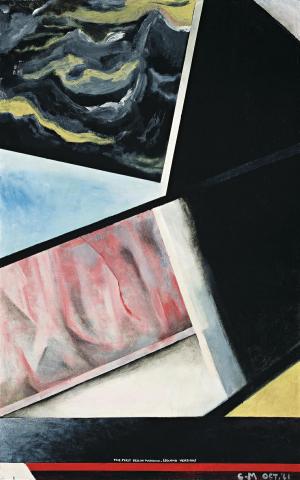THE FIRST BELLINI MADONNA (SECOND VERSION), 1961
Colin McCahon
enamel on board
120.5 x 75.5 cm
signed and dated lower right: C.M Oct. ‘61
inscribed lower centre: THE FIRST BELLINI MADONNA. [SECOND VERSION]
Martin Browne Fine Art, Sydney
Private collection, New South Wales
20th Century Australian and New Zealand Painting, Martin Browne Fine Art, Sydney, March – April 1995, cat. 18
Colin McCahon: A Question of Faith, Stedelijk Museum, Amsterdam, The Netherlands, August – November 2002, then touring to: City Gallery, Wellington, NZ; Auckland Art Gallery Toi o Tamaki, Auckland, NZ; National Gallery of Victoria, Melbourne, Australia; Art Gallery of New South Wales, Sydney, Australia.
Brown, G.H., Colin McCahon, Artist, A.H. & A.W. Reed Ltd, Wellington NZ, 1984, pp. 73, 125–127, 144
Bloem, M., & Browne, M., Colin McCahon: A Question of Faith, Stedelijk Museum, Amsterdam & Craig Potton Publishing, New Zealand, 2002, pp. 92, 196, 197, (illus. p. 92)
The Colin McCahon Database and Image Library # cm001516
'The inspiration for the Bellini Madonna series resulted from Colin undergoing religious instruction within the Catholic Church, c.1959-62. These attempts at a Marian subject reflected the huge difficulty he was having with the notion of the bodily assumption of the Virgin Mary, which was at odds with his background of Presbyterian and Quaker philosophies. Ultimately he was asked to submit to the authority of the Church by swearing belief in the Marian concept, a commitment normally only required of priests who take confession. Colin could not do so and his religious training ceased.'1
As implied by the title, the series of five paintings collectively known as the 'Bellini Madonnas' pays poignant homage to the Venetian Renaissance artist, Giovanni Bellini (c.1430-1516) whom McCahon had long admired for the tenderness, sensuousness and humanity with which he infused his work. Extrapolating from certain compositional structures in favourite images by the old master, McCahon explored the possibilities they offered to address his ongoing challenge to introduce a third dimension to the two-dimensional picture plane - 'a way through' as he had previously pursued in the Gate paintings (see lot 17).
Of particular influence were Bellini's'Madonna and Child' paintings such as his celebrated Madonna of the Pear which typically feature Mary and the Holy Infant juxtaposed before a low marble sill overlooking a landscape scene. Indeed, as the present First Bellini Madonna (second version), 1961-62, illustrates, the series constituted a powerful reworking and synthesis of the Italian artost's main compositional structures, decorative effects and symbology. For example, where Bellini typically triangulated these compositions, McCahon here employs a similar triple overlaying of planes, as well as emulates details such as the inscribed title lower right, the marbling effect of the sill, and the triangular corner shapes. Yet while Bellini's original audience would have instantly appreciated his allusions to the Trinity, for contemporary viewers arguably less conversant with Christian symbolism, McCahon's message remains perhaps more elusive. Instructive therefore, are the insights offered by the artist's son, William McCahon, into the present work:
'The confounding figure of Godhead appears partly stated above the horizon, its base on the left-hand margin and its form implying that it is an ever-repeating triangular shape' The abstracted figure rising above the landscape shows two natures, one each for Christ and Mary. The black, white and gold marbling, together with the blue of the sky, represents Mary... Christ is the area beneath. Here, in the red marbling, Christ's blood becomes a sunset, with the white light of a sunlit rainstorm below. Within the 'sunset', Colin uses the 'crescent moon' wound symbol that Bellini almost always used when portraying the dead Christ. The complex black area is God, the unknowable, the void'
By the composition, Colin seems to be saying that Mary and Christ are part of God and the Trinity. This group is flanked by the two implied triangles that cut the top corners of some of Bellini's works. Here, the yellow one symbolizes truth revealed and the two combine with the Madonna's pure blue triangle to restate the Trinity in a third way. Bellini's marble sill is now the edge of the world and the sky beyond a new Trinity comprising God, Christ and Mary. In this one highly complex image, Colin has succeeded in paying homage to Bellini as one of his de-facto teachers; extended his efforts to introduce the sense of a third dimension into the picture plane first explored in the preceding Gate series; and found a way to give a visual representation to the viewing of God - albeit an oblique view of one of God's many manifestations.'2
1. William McCahon,'The First Bellini Madonna (second version)', unpublished essay, January 2002 cited in Bloem, M. & Browne, M., Colin McCahon: A Question of Faith, Stedelijk Museum, Amsterdam & Craig Potton Publishing, New Zealand, 2002, p. 196
2. ibid., p. 197
VERONICA ANGELATOS
